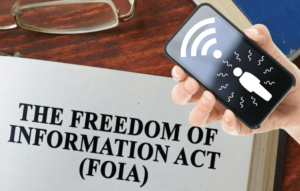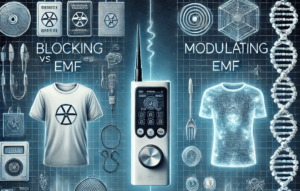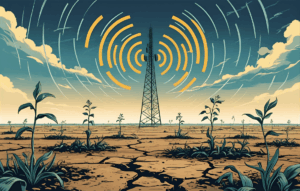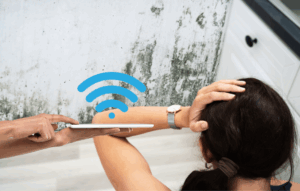Let’s start with the elephant in the oncology room: breast cancer is now the most commonly diagnosed cancer among women under 50 in the United States. According to a 2023 study in JAMA Network Open, over 12,600 new cases of breast cancer were diagnosed in U.S. women under 50 in 2019 alone. Globally, a 2023 BMJ Oncology paper confirmed the same disturbing trend: breast cancer is leading in both incidence and death for women in this younger age bracket.
Why is this happening? Genetic predisposition? Environmental toxins? Processed foods? Sure—those all play a role. But here’s the unnerving twist: several experts, including respected epidemiologist Dr. Devra Davis, are pointing to another overlooked culprit… the cellphone.
Could Cell Phones Be Fueling Breast Cancer?
Dr. Davis, founder of Environmental Health Trust and former head of the Board on Environmental Studies and Toxicology for the National Research Council, has been warning about the dangers of EMFs (electromagnetic fields) for decades. She told the Defender that, unequivocally: “There’s clear compelling evidence that electromagnetic fields accelerate the growth of breast cancer cells.”
We’re not talking vague correlations here. The MCF-7 breast cancer cell line, a well-studied estrogen receptor-positive cell type, has been shown in multiple lab studies to grow more aggressively when exposed to RF (radiofrequency) radiation. And guess what emits RF radiation? Yep, your phone.
This isn’t just about heat or thermal effects, though that’s often the defense. It’s about the biological signaling disruption at a cellular level. Some researchers have even called EMFs (electromagnetic fields) a form of digital endocrine disruptor, manipulating hormone-sensitive tissues in new and concerning ways.
The Breast: Fat, Fluid, and Radiation Sponges
It doesn’t help that the breast is made up largely of fat and fluid—perfect mediums for radiofrequency waves to travel through. Dr. Davis explains that RF radiation moves easily through these tissues, penetrating and interacting at the cellular level in ways we’re only beginning to fully understand.
Fat stores toxins, too—making it a kind of chemical sink for environmental exposures. Combine that with prolonged RF exposure and you’re cooking up a recipe for cell damage, oxidative stress, and potentially, tumor formation.
Real-Life Cases Are Piling Up
In a 2013 case report co-authored by breast surgeon Dr. John West, four women developed tumors in areas of the breast directly underneath where they stored their phones in their bras for years. These women were young. None had a family history of breast cancer. The common link? All had the habit of carrying their phones pressed against their skin.
This wasn’t just a coincidence. The tumors had bizarrely similar characteristics, suggesting a pattern of causation, not just correlation. The pathology showed multifocal tumors and similar histological features. That’s not something we typically see in sporadic, unrelated breast cancers.

The Case of Tiffany Frantz
Tiffany Frantz was just 21 when she was diagnosed with an aggressive form of breast cancer. She had no genetic predisposition. No family history. But she did have one thing: a five-year habit of keeping her phone in her bra, directly against her skin. The tumors lined up exactly where the phone had been.
She fought courageously for nearly a decade, but sadly, Tiffany passed away in 2021 at age 31. Her story is one of several now documented, and it’s forcing both doctors and scientists to reevaluate what we once assumed was harmless.
Understanding the Science Behind the Risk
Cell phones emit non-ionizing microwave radiation, which is part of the broader electromagnetic spectrum. While it doesn’t have enough energy to ionize atoms or molecules (like X-rays do), it still interacts with biological tissues, especially when the device is pressed directly against the skin.
Non-ionizing doesn’t mean non-harmful. The oxidative stress theory is one of the leading explanations for how EMFs disrupt cellular function. They increase reactive oxygen species (ROS), damage mitochondria, and alter gene expression—all of which can fuel cancer development over time.
1. New Research from Taiwan Adds to the Evidence
In a 2020 peer-reviewed study, researchers analyzed smartphone usage behaviors in 211 women with breast cancer and 894 healthy controls. The results were eye-opening:
Smartphone addiction was linked to a 1.43x higher breast cancer risk.
Using a smartphone for more than 4.5 minutes before bedtime was associated with a 5.27x higher risk.
Holding the phone within 10 cm of the chest increased risk by 1.59x.
Carrying the phone in a bra or near the waist-abdomen increased risk by 5.03x and 4.06x, respectively.
The authors emphasized that both RF radiation and melatonin suppression from nighttime phone use may drive this risk. Most concerning? There was a synergistic effect between addiction and bedtime use, skyrocketing the risk to nearly 7 times that of controls.
2. Endocrine Disruption and Hormonal Mayhem
In a 2023 review, Dr. Davis and co-authors highlighted how EMFs act like endocrine disruptors, impacting the hypothalamic-pituitary-gonadal (HPG) axis. This system regulates everything from menstrual cycles to estrogen production. Disruption here could fuel hormone-sensitive cancers like breast cancer.
Hormone signaling pathways don’t like noise. EMFs create electromagnetic “static” in the body, throwing off cellular communication and hormone regulation. It’s not a stretch to imagine how chronic exposure could contribute to conditions driven by hormonal imbalance.
3. Melatonin: A Natural Defense, Now Compromised
Exposure to blue light and EMFs before bedtime can suppress melatonin, the body’s sleep hormone. Melatonin also has protective effects against cancer, including anti-estrogenic activity. One intriguing data point? Blind women, who naturally produce more melatonin, have half the breast cancer risk of sighted women.
Melatonin’s role in cellular detox and apoptosis (programmed cell death) makes it a key defender against rogue cell growth. Lower melatonin levels mean impaired nightly detox and increased vulnerability to environmental stressors—especially in breast tissue.
Did the FDA Ignore the Evidence on Cellphone Radiation?
Yes—but not without controversy. In 2016, the National Toxicology Program (NTP) completed a $30 million study at the FDA’s request. The conclusion? “Clear evidence” that RF radiation caused cancer and DNA damage in lab animals. Then, in 2020, the FDA rejected its own commissioned study. Dr. Davis called it out as “deeply flawed and hypocritical.”
It begs the question: Why fund a massive study only to discredit it when the results are inconvenient?
The NTP findings were backed by other global agencies. The Ramazzini Institute in Italy conducted similar rodent studies at far lower power levels and found nearly identical results. It’s becoming harder and harder to write off these findings as chance.
The WHO’s Classification: A Decade-Old Warning
Back in 2011, the World Health Organization classified cellphone radiation as a Group 2B “possible” carcinogen. Over a decade later, many experts, including some of those originally on the WHO panel, are now calling for an upgrade to the classification—perhaps to Group 2A (“probable”) or even Group 1 (“known”).
Meanwhile, telecom lobbying continues to cloud regulatory decisions. Unlike asbestos or tobacco, where regulators eventually acted, we’re still stuck in a digital Wild West with outdated safety standards.
Hidden Warnings in Smartphone Manuals: What the Fine Print Reveals About Radiation Exposure
You won’t find it on the packaging, and nobody’s shouting it in ads—but your smartphone’s manual contains a curious little disclaimer: don’t keep this device directly against your body. Most major brands recommend a 5–15 mm buffer.
Why? Because:
The phone emits measurable radiation, even in standby mode.
Close contact increases absorption into nearby tissues.
Here’s the twist:
This disclaimer is buried deep in your phone’s settings or fine print.
It’s not plastered on retail boxes or screens where you’d notice.
This legal language, technically disclosed but practically hidden, is designed to cover liability while keeping consumers unaware. It’s a modern version of plausible deniability. A ‘gotcha’ clause if things ever go sideways.
So next time you tuck your phone into your bra, pocket, or waistband, just remember: even the people who made it are quietly suggesting you don’t.
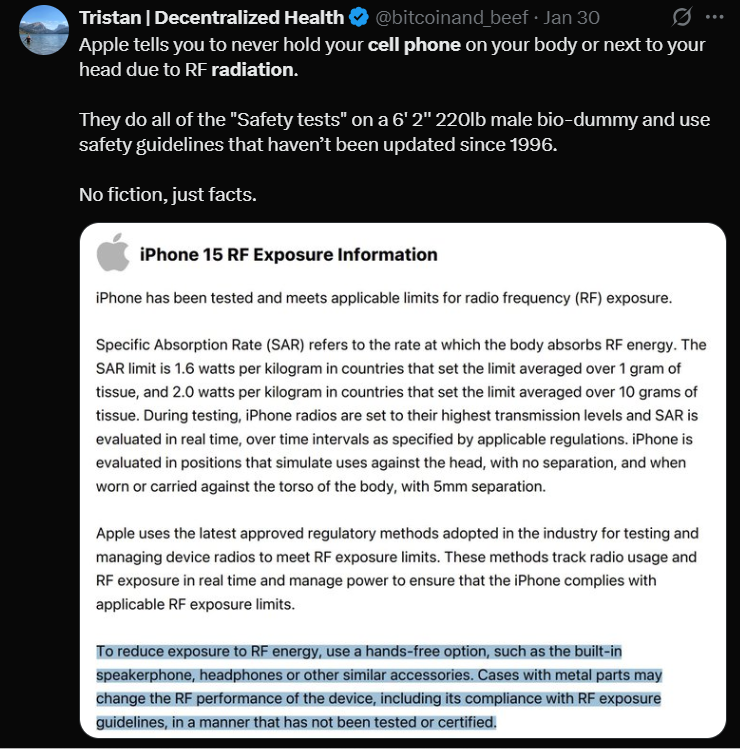
Practical Steps to Reduce RF EMF Exposure
Never store your phone in your bra
Keep your phone on Airplane Mode when carrying it close to your body
Use speakerphone or wired earbuds for calls
Avoid sleeping with your phone near your chest or under your pillow
Use a wired internet connection instead of Wi-Fi if possible
Use EMF-protecting technology from Aires to neutralize harmful radiation (save 25% with code “KYLETOTHEMOON”)
Final Thoughts: It’s Time to Ask the Hard Questions
We live in a hyper-connected world where cellphones have become an extension of our bodies. But convenience should never come at the expense of our health.
The rise in early-onset breast cancer deserves serious attention—and that includes rethinking how we interact with our tech. The science isn’t perfect, but there is enough evidence now to warrant caution, especially when lives like Tiffany Frantz’s are on the line.
This isn’t about fear—it’s about informed action. Technology is here to stay, but how we use it can evolve. We don’t need to live like we’re in a Faraday cage, but we do need to stop pretending the risk is zero.
The conversation around breast cancer prevention needs to catch up to the reality of modern environmental exposures. And it starts with awareness.
So let’s keep asking questions. Let’s challenge the status quo. Let’s protect our bodies in a world that too often treats them like afterthoughts.





